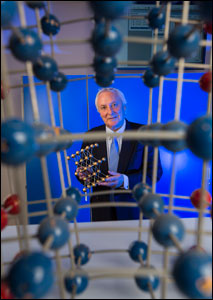Please note, this page has been archived and is no longer being updated.
One of Swansea University’s most distinguished graduates returned to his alma mater this week (Wednesday, September 26), to open new £3million state-of-the-art laboratories and teaching rooms to educate the next generation of scientists.
 Professor Lyn Evans CBE FRS, who led the international project to build the Large Hadron Collider (LHC) at CERN, graduated from Swansea University with a first class degree in Physics in 1966 and his PhD in 1970.
Professor Lyn Evans CBE FRS, who led the international project to build the Large Hadron Collider (LHC) at CERN, graduated from Swansea University with a first class degree in Physics in 1966 and his PhD in 1970.
As Project Leader of the LHC at CERN – the European Organisation for Nuclear Research – he was at the centre of operations during the construction and commissioning stage, through to the LHC’s start-up on September 10, 2008.
Professor Evans visited the University’s College of Science to open a newly refurbished suite of science laboratories and teaching rooms, located in the Wallace Building.
The facility, which includes Physics laboratories, Biological Science laboratories, Geology laboratories, a novel group teaching laboratory and an IT suite, have been refurbished as part of the University’s ongoing commitment to enhance the learning and teaching environment.
The laboratories comprise a full range of AV facilities able to transmit output from a variety of sources including microscopes, PCs, DVD/video players and visualise/camera units to several plasma screens.
The facilities comply with all DDA requirements and include Induction Loops for students with hearing difficulties and adjustable benches for disabled students.
The refurbishment has resulted in significantly upgraded facilities to teach a higher level of transferable laboratory techniques and skills.
Professor Evans, who was made an Honorary Fellow of the University in 2002, said: “It was an honour to be asked to open the College’s new laboratories and teaching facilities, at the University where I myself studied as an undergraduate student and began my own physics research and career path – a path which eventually led me to CERN and the opportunity to work on one of the world’s largest and most exciting experiments with the LHC.
“I sincerely hope this investment in the learning and teaching ofSwansea’s current and future physicists will reap great rewards.”
 Professor Steve Wilks, Head of the College of Science at Swansea University, said: “Professor Lyn Evans represents the epitome of world-class research excellence, for which the College and the University continually strives.
Professor Steve Wilks, Head of the College of Science at Swansea University, said: “Professor Lyn Evans represents the epitome of world-class research excellence, for which the College and the University continually strives.
“It was truly a privilege to welcome him again to Swansea, to open our new undergraduate laboratories and teaching rooms. These improved facilities will educate what we hope will be the next generation of world-class scientists – many of whom I’m sure will be inspired by this former Swansea student and his achievements.”
The laboratories and teaching rooms’ refurbishment was made possible through the University’s capital programme, the College of Science, and a generous bequest made to the Physics Department by Dr Gething Morgan Lewis FRSE, an eminent physicist who grew up in Ystalyfera in the Swansea Valley and was educated at Brecon College.
Dr Lewis, who passed away in February 2009, worked on radar during WWII and in the 1960s was one of the pioneers of the experimental particle physics group at the University of Glasgow, where he continued to work until his retirement as senior lecturer in 1979. Through his particle physics research, Dr Lewis had close links with CERN and was a Fellow of The Royal Society Edinburgh.
Following the opening of the College’s new facility, Professor Evans gave a Swansea Science Café talk on the subject of ‘The Large Hadron Collider at CERN’, at the city’s Dylan Thomas Centre.
The LHC, located at CERN in Geneva, Switzerland, in a gigantic 27km-circumference, underground tunnel on the French-Swiss border, was built over 10 years at the cost of several billion pounds.
The LHC produces proton-proton collisions at the highest energies yet studied. These create, in a very small region, the conditions of the early universe, a billionth of a second after the ‘Big Bang’.
Swansea Science Café co-organiser, Professor Chris Allton, of Swansea University’s Department of Physics, said: “I want to pay tribute to Dr Lewis for his overwhelmingly generous bequest, which has been crucial in the refurbishment of the Physics laboratory.
“It was also great to have such an eminent physicist as Professor Evans here to open the laboratories and teaching spaces and it was wonderful to have him speaking at the Swansea Science Café, which proved to be one of the most popular and well attended events to date.
“In years to come, our Physics students will gain enormous inspiration when they see the plaque on the wall and know that the person who went on to build the Large Hadron Collider was once an undergraduate student in this Physics Department in this University, just like they’ll be."
Pictures from the official opening of the new College of Science laboratories and teaching rooms can be viewed here http://www.flickr.com/photos/swanseauniversity/sets/72157631634612807/.
A recording of Professor Evans’s Swansea Science Café talk will be available shortly on Swansea University’s YouTube channel, which can be found here http://www.youtube.com/swanseaunivideo.
Above images:
1) Professor Lyn Evans with atomic structure models in the new Physics laboratories, College of Science.
2) Left-right, Professor Noel Thompson, Swansea University Pro-Vice-Chancellor (Research), Professor Steve Wilks, Head of Swansea University's College of Science, and Professor Lyn Evans, during the official opening.
- Wednesday 3 October 2012 01.00 BST
- Thursday 27 September 2012 13.08 BST
- Swansea University, Tel: 01792 295049
